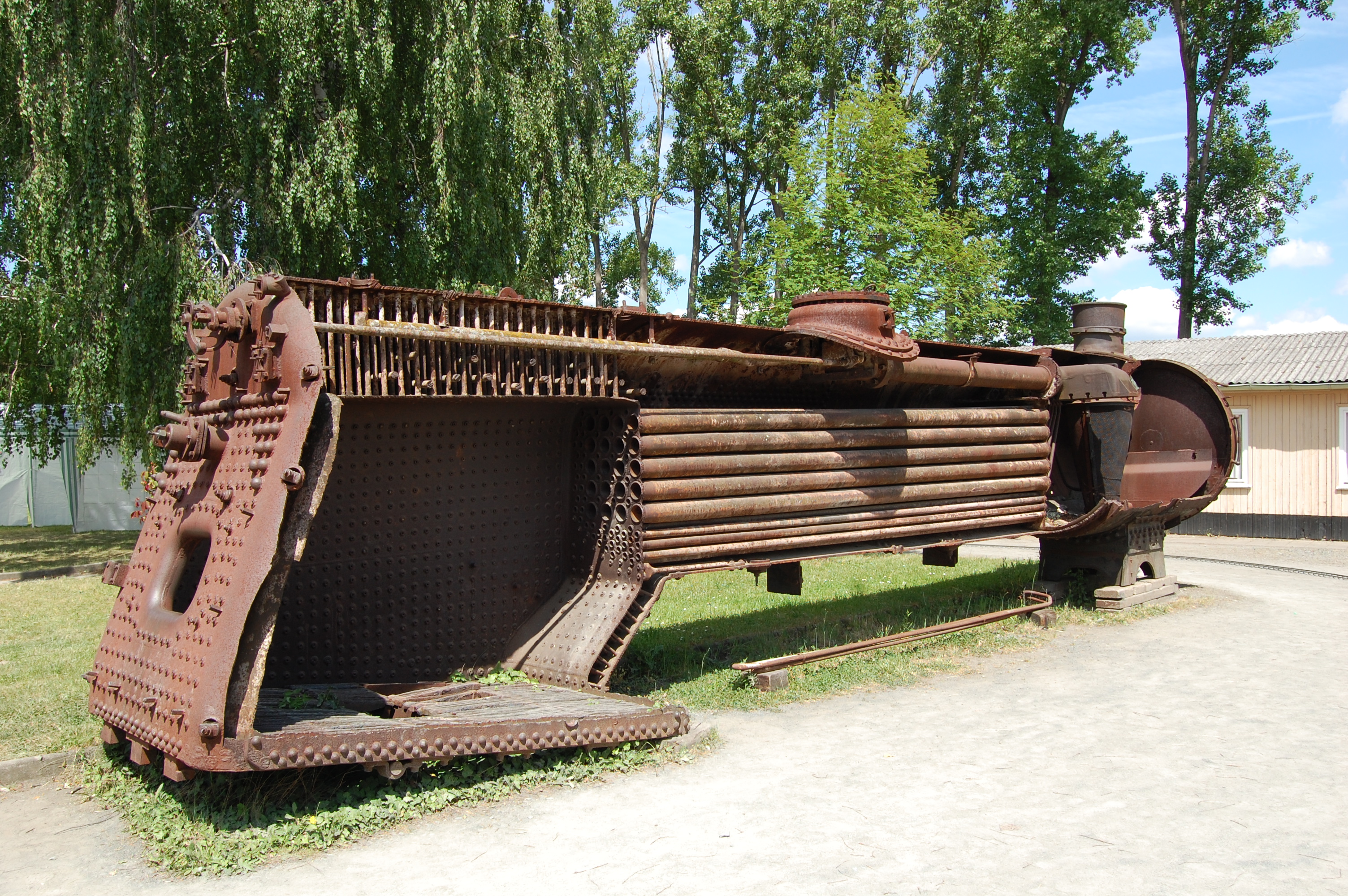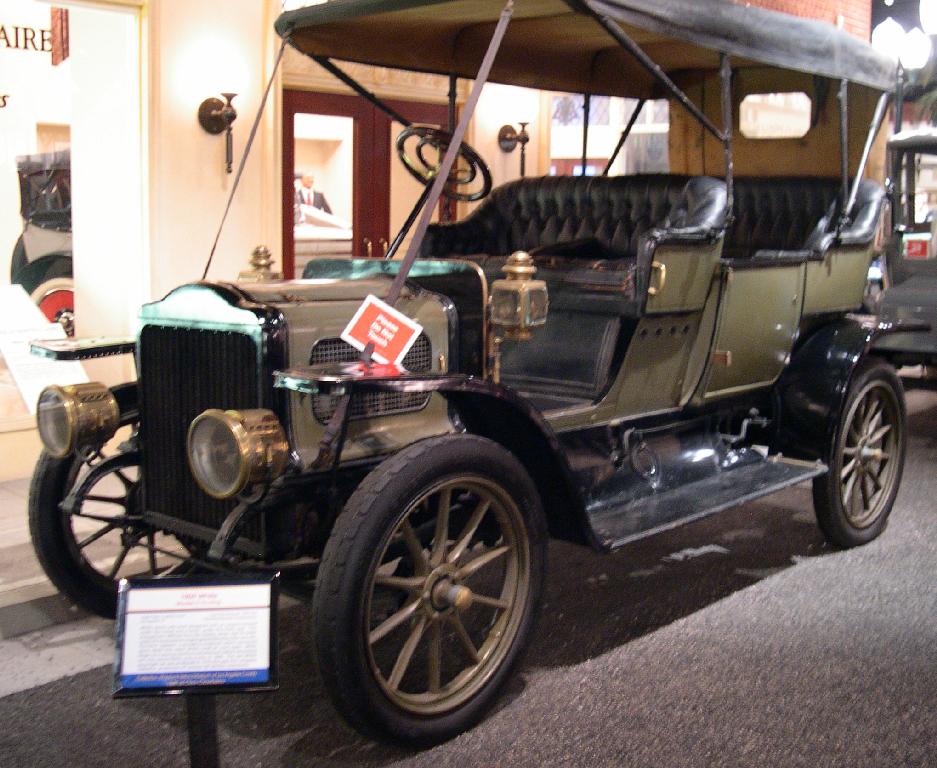|
Sentinel Boiler
The Sentinel boiler was a design of vertical boiler, fitted to the numerous steam wagons built by the Sentinel Waggon Works. The boiler was carefully designed for use in a steam wagon: it was compact, easy to handle whilst driving, and its maintenance features recognised the problems of poor feedwater quality and the need for it to be maintained by a small operator, rather than a major locomotive works. Although this design was used in most of Sentinel's products, they also produced larger boilers of quite different types for their railway locomotives. Description Sentinel boilers are vertical, as was common for many designs of steam wagon, so as to reduce the effects of tilting due to hill climbing or uneven roads disturbing the water level. It also provides a compact boiler that leaves adequate space in the cab for the crew, controls and coal bunker, whilst leaving as much as possible of the wagon's overall length available for the useful load. The boiler is a watertu ... [...More Info...] [...Related Items...] OR: [Wikipedia] [Google] [Baidu] |
W & J Galloway & Sons
W & J Galloway and Sons was a British manufacturer of steam engines and boilers based in Manchester, England. The firm was established in 1835 as a partnership of two brothers, William and John Galloway. The partnership expanded to encompass their sons and in 1889 it was restructured as a limited liability company. It ceased trading in 1932. The Galloway brothers had been apprenticed to another partnership involving their father, a maker of waterwheels and gearing for mills, before setting up in business on their own account. Their firm grew to be a specialist producer of steam engines and industrial boilers with a worldwide customer base and a reputation for ingenuity. Their products were used in such diverse areas as electricity generation and refrigeration. The business grew with the increasing application of steam power in industry, and it died with industry's move to the application of electric power. History Galloway, Bowman and Glasgow William Galloway was born on 5 Marc ... [...More Info...] [...Related Items...] OR: [Wikipedia] [Google] [Baidu] |
Locomotive Boiler
A fire-tube boiler is a type of boiler in which hot gases pass from a fire through one or more tubes running through a sealed container of water. The heat of the gases is transferred through the walls of the tubes by thermal conduction, heating the water and ultimately creating steam. The fire-tube boiler developed as the third of the four major historical types of boilers: low-pressure tank or " haystack" boilers, flued boilers with one or two large flues, fire-tube boilers with many small tubes, and high-pressure water-tube boilers. Their advantage over flued boilers with a single large flue is that the many small tubes offer far greater heating surface area for the same overall boiler volume. The general construction is as a tank of water penetrated by tubes that carry the hot flue gases from the fire. The tank is usually cylindrical for the most part—being the strongest practical shape for a pressurized container—and this cylindrical tank may be either horizontal or ve ... [...More Info...] [...Related Items...] OR: [Wikipedia] [Google] [Baidu] |
Three-drum Boilers
Three-drum boilers are a class of water-tube boiler used to generate steam, typically to power ships. They are compact and of high evaporative power, factors that encourage this use. Other boiler designs may be more efficient, although bulkier, and so the three-drum pattern was rare as a land-based stationary boiler. The fundamental characteristic of the "three-drum" design is the arrangement of a steam drum above two water drums, in a triangular layout. Water tubes fill in the two sides of this triangle between the drums, and the furnace is in the centre. The whole assembly is then enclosed in a casing, leading to the exhaust flue. Firing can be by either coal or oil. Many coal-fired boilers used multiple firedoors and teams of stokers, often from both ends. Development Development of the three-drum boiler began in the late 19th century, with the demand from naval ships that required high power and a compact boiler. The move to water-tube boilers had already begun, with ... [...More Info...] [...Related Items...] OR: [Wikipedia] [Google] [Baidu] |
Abner Doble
Abner Doble (March 26, 1890 – July 16, 1961) was an American mechanical engineer who built and sold steam-powered automobiles as Doble Steam Cars. His steam engine design was used in various automobiles from the early 1900s, including a 1969 General Motors prototype and the first successful steam-powered aeroplane. Family history Doble was born on March 26, 1890, in San Francisco, one of four brothers. His father was William Ashton Doble, son of the inventor of the Doble water wheel. Doble's forebears had migrated from England to the US in the mid-1700s. William's father Abner was born in Indiana. He had been a sailor, a smith, and a lumberman, who became a journeyman blacksmith and subsequently became partner in Nelson and Doble. The company became one of the biggest manufacturers of miner's and blacksmith's tools on the US Pacific coast during the California Gold Rush. The company became famous manufacturing Abner Doble's water wheel turbines for mining applications. ... [...More Info...] [...Related Items...] OR: [Wikipedia] [Google] [Baidu] |
Steam Car
A steam car is a car (automobile) propelled by a steam engine. A steam engine is an external combustion engine (ECE) in which the fuel is combusted outside of the engine, unlike an internal combustion engine (ICE) in which fuel is combusted inside the engine. ECEs have a lower thermal efficiency, but carbon monoxide production is more readily regulated. Steam-powered automobiles were popular with early buyers. Steam was safe, reliable, and familiar. People had decades of experience with it in trains and boats, and even in experimental road vehicles. However, early steam cars required constant care and attention—and up to 30 minutes to start. Automated quick-firing boilers solved these problems, but not before more efficient gasoline engines dominated the market and made steam cars obsolete. The first experimental steam-powered cars were built in the 18th and 19th centuries, but it was not until after Richard Trevithick had developed the use of high-pressure steam around 180 ... [...More Info...] [...Related Items...] OR: [Wikipedia] [Google] [Baidu] |
Vertical Boiler With Horizontal Fire-tubes
A vertical boiler with horizontal fire-tubes is a type of small vertical boiler, used to generate steam for small machinery. It is characterised by having many narrow fire-tubes, running horizontally. Boilers like this have been widely used on ships as either '' auxiliary'' or ''donkey'' boilers. Smaller examples, particularly the Robertson type have been used for steam wagons. Parallel tube boilers Parallel tube boilers place all of their fire-tubes in a single parallel group, running from side to side of the boiler shell. The best known of these is the Cochran design. Cochran boiler The Cochran boiler was produced by Cochran & Co. of Annan, Scotland. It is widely used in marine practice, either fired directly by coal or oil fuels, or else used for heat recovery from the exhaust of large diesel engines. Where such a boiler may be heated either by the exhaust gases of the main propulsion plant, or else separately fired when in port (usually by oil rather than coal) it ... [...More Info...] [...Related Items...] OR: [Wikipedia] [Google] [Baidu] |
List Of Boiler Types, By Manufacturer
There have been a vast number of designs of steam boiler, particularly towards the end of the 19th century when the technology was evolving rapidly. A great many of these took the names of their originators or primary manufacturers, rather than a more descriptive name. Some large manufacturers also made boilers of several types. Accordingly, it is difficult to identify their technical aspects from merely their name. This list presents these known, notable names and a brief description of their main characteristics. See also * Glossary of boiler terminology Boilers for generating steam or hot water have been designed in countless shapes, sizes and configurations. An extensive terminology has evolved to describe their common features. This glossary provides definitions for these terms. Terms which re ... A B C D E F G H I J K L M N O P R S T V W Y References *{{cite book , title=Marin ... [...More Info...] [...Related Items...] OR: [Wikipedia] [Google] [Baidu] |
LNER Class Y1
The LNER Class Y1 was a class of 0-4-0 geared steam locomotives built by Sentinel Waggon Works for the London and North Eastern Railway and introduced in 1925. They passed into British Railways ownership in 1948 and were numbered 68130-68153 but 68134 was withdrawn almost immediately and may not have carried its BR number. Power unit The superheated vertical water-tube boiler and the engine were similar to those used in Sentinel steam wagons. There were variations within the class as regards boiler size and fuel capacity and these were denoted by sub-classes Y1/1 to Y1/4. The engines had poppet valves and reversing was by sliding camshaft. The advantage of the water-tube boiler was that steam could be raised much more quickly than with a conventional fire-tube boiler. Transmission Final drive to the wheels was by sprocket chain. Some engines had a gear ratio of 11:25 and some 9:25. Tractive effort was: * Ratio 11:25, 7,260 lbf (68130-68142 and 68152-68153) * Rati ... [...More Info...] [...Related Items...] OR: [Wikipedia] [Google] [Baidu] |
Standard Gauge
A standard-gauge railway is a railway with a track gauge of . The standard gauge is also called Stephenson gauge (after George Stephenson), International gauge, UIC gauge, uniform gauge, normal gauge and European gauge in Europe, and SGR in East Africa. It is the most widely used track gauge around the world, with approximately 55% of the lines in the world using it. All high-speed rail lines use standard gauge except those in Russia, Finland, and Uzbekistan. The distance between the inside edges of the rails is defined to be 1435 mm except in the United States and on some heritage British lines, where it is defined in U.S. customary/Imperial units as exactly "four feet eight and one half inches" which is equivalent to 1435.1mm. History As railways developed and expanded, one of the key issues was the track gauge (the distance, or width, between the inner sides of the rails) to be used. Different railways used different gauges, and where rails of different gauge m ... [...More Info...] [...Related Items...] OR: [Wikipedia] [Google] [Baidu] |
Shire Books
Shire Books are published by Bloomsbury Publishing, a book publishing company based in London, England, and formerly by Shire Publications Ltd. and Osprey Publishing. Shire offers low priced, concise non-fiction paperbacks on a wide range of subjects. Shire books cover antiques and collectables, motoring and rural history, archaeology and Egyptology, architecture, industrial history and many other topics. First decades Founded in 1962 by John Rotheroe, the company was for many years based in Princes Risborough, Buckinghamshire. The first book published by Shire was ''Discovering East Suffolk'', a 24-page guide to the county through a series of five motoring routes and a gazetteer of the main towns and villages. It was given away to visitors via coach operators, local churches and tourist information points. The book was successful and when it was realized that many of the copies given away were being resold it was decided to sell the second edition, and this set the template fo ... [...More Info...] [...Related Items...] OR: [Wikipedia] [Google] [Baidu] |
.jpg)





.jpg)
.jpg)